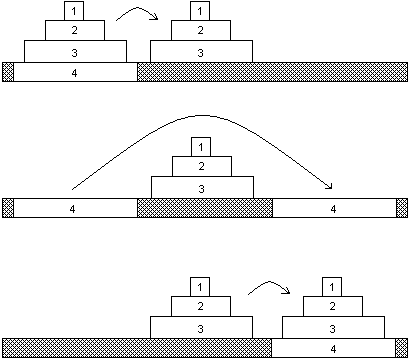The idea of regarding problem solving as a search problem originated from Alan Newell and Herbert Simon while trying to design computer programs which could solve certain problems. This led them to develop a program called General Problem Solver which was able to solve any well-defined problem by creating heuristics on the basis of the user's input. This input consisted of objects and operations that could be done on them.
As we already know, every problem is composed of an initial state, intermediate states and a goal state (also: desired or final state), while the initial and goal states characterise the situations before and after solving the problem. The intermediate states describe any possible situation between initial and goal state. The set of operators builds up the transitions between the states. A solution is defined as the sequence of operators which leads from the initial state across intermediate states to the goal state.
The simplest method to solve a problem, defined in these terms, is to search for a solution by just trying one possibility after another (also called trial and error).
As already mentioned above, an organised search, following a specific strategy, might not be helpful for finding a solution to some ill-defined problem, since it is impossible to formalise such problems in a way that a search algorithm can find a solution.
As an example we could just take Knut and his essay: he has to find out about his own opinion and formulate it and he has to make sure he understands the sources texts. But there are no predefined operators he can use, there is no panacea how to get to an opinion and even not how to write it down.
Means-End Analysis
In Means-End Analysis you try to reduce the difference between initial state and goal state by creating subgoals until a subgoal can be reached directly (probably you know several examples of recursion which works on the basis of this).
An example for a problem that can be solved by Means-End Analysis are the "Towers of Hanoi":
Towers of Hanoi – A well defined problem
The initial state of this problem is described by the different sized discs being stacked in order of size on the first of three pegs (the “start-peg“). The goal state is described by these discs being stacked on the third pegs (the “end-peg“) in exactly the same order.

There are three operators:
- You are allowed to move one single disc from one peg to another one
- You are only able to move a disc if it is on top of one stack
- A disc cannot be put onto a smaller one.

In order to use Means-End Analysis we have to create subgoals. One possible way of doing this is described in the picture:
1. Moving the discs lying on the biggest one onto the second peg.
2. Shifting the biggest disc to the third peg.
3. Moving the other ones onto the third peg, too
You can apply this strategy again and again in order to reduce the problem to the case where you only have to move a single disc – which is then something you are allowed to do.
Strategies of this kind can easily be formulated for a computer; the respective algorithm for the Towers of Hanoi would look like this:
1. move n-1 discs from A to B
2. move disc #n from A to C
3. move n-1 discs from B to C
where n is the total number of discs, A is the first peg, B the second, C the third one. Now the problem is reduced by one with each recursive loop.
Means-end analysis is important to solve everyday-problems – like getting the right train connection: You have to figure out where you catch the first train and where you want to arrive, first of all. Then you have to look for possible changes just in case you do not get a direct connection. Third, you have to figure out what are the best times of departure and arrival, on which platforms you leave and arrive and make it all fit together.
Analogies
Analogies describe similar structures and interconnect them to clarify and explain certain relations. In a recent study, for example, a song that got stuck in your head is compared to an itching of the brain that can only be scratched by repeating the song over and over again.
Restructuring by Using Analogies
One special kind of restructuring, the way already mentioned during the discussion of the Gestalt approach, is analogical problem solving. Here, to find a solution to one problem – the so called target problem, an analogous solution to another problem – the source problem, is presented.
An example for this kind of strategy is the radiation problem posed by K. Duncker in 1945:
As a doctor you have to treat a patient with a malignant, inoperable tumour, buried deep inside the body. There exists a special kind of ray, which is perfectly harmless at a low intensity, but at the sufficient high intensity is able to destroy the tumour – as well as the healthy tissue on his way to it. What can be done to avoid the latter?
When this question was asked to participants in an experiment, most of them couldn't come up with the appropriate answer to the problem. Then they were told a story that went something like this:
A General wanted to capture his enemy's fortress. He gathered a large army to launch a full-scale direct attack, but then learned, that all the roads leading directly towards the fortress were blocked by mines. These roadblocks were designed in such a way, that it was possible for small groups of the fortress-owner's men to pass them safely, but every large group of men would initially set them off. Now the General figured out the following plan: He divided his troops into several smaller groups and made each of them march down a different road, timed in such a way, that the entire army would reunite exactly when reaching the fortress and could hit with full strength.
Here, the story about the General is the source problem, and the radiation problem is the target problem. The fortress is analogous to the tumour and the big army corresponds to the highly intensive ray. Consequently a small group of soldiers represents a ray at low intensity. The solution to the problem is to split the ray up, as the general did with his army, and send the now harmless rays towards the tumour from different angles in such a way that they all meet when reaching it. No healthy tissue is damaged but the tumour itself gets destroyed by the ray at its full intensity.
M. Gick and K. Holyoak presented Duncker's radiation problem to a group of participants in 1980 and 1983. Only 10 percent of them were able to solve the problem right away, 30 percent could solve it when they read the story of the general before. After given an additional hint – to use the story as help – 75 percent of them solved the problem.
With this results, Gick and Holyoak concluded, that analogical problem solving depends on three steps:
1. Noticing that an analogical connection exists between the source and the target problem.
2. Mapping corresponding parts of the two problems onto each other (fortress → tumour, army → ray, etc.)
3. Applying the mapping to generate a parallel solution to the target problem (using little groups of soldiers approaching from different directions → sending several weaker rays from different directions)
Next, Gick and Holyoak started looking for factors that could be helpful for the noticing and the mapping parts, for example:
Discovering the basic linking concept behind the source and the target problem.
-->picture coming soon<--
Schema
The concept that links the target problem with the analogy (the “source problem“) is called problem schema. Gick and Holyoak obtained the activation of a schema on their participants by giving them two stories and asking them to compare and summarise them. This activation of problem schemata is called “schema induction“.
The two presented texts were picked out of six stories which describe analogical problems and their solution. One of these stories was "The General" (remember example in Chapter 4.1).
After solving the task the participants were asked to solve the radiation problem (see chapter 4.2). The experiment showed that in order to solve the target problem reading of two stories with analogical problems is more helpful than reading only one story: After reading two stories 52% of the participants were able to solve the radiation problem (As told in chapter 4.2 only 30% were able to solve it after reading only one story, namely: “The General“).
Gick and Holyoak found out that the quality of the schema a participant developed differs. They classified them into three groups:
- Good schemata: In good schemata it was recognised that the same concept was used in order to solve the problem (21% of the participants created a good schema and 91% of them were able to solve the radiation problem).
- Intermediate schemata: The creator of an intermediate schema has figured out that the root of the matter equals (here: many small forces solved the problem). (20% created one, 40% of them had the right solution).
- Poor schemata: The poor schemata were hardly related to the target problem. In many poor schemata the participant only detected that the hero of the story was rewarded for his efforts (59% created one, 30% of them had the right solution).
The process of using a schema or analogy, i.e. applying it to a novel situation is called transduction. One can use a common strategy to solve problems of a new kind.
To create a good schema and finally get to a solution is a problem-solving skill that requires practise and some background knowledge.




